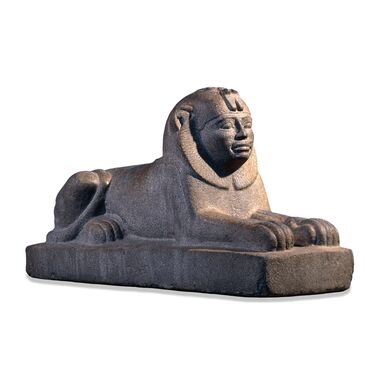
The Sphinx of Taharqo
Brief Identification[]
The Sphinx of Taharqo was discovered at Kawa, northern Sudan in the Temple of Amun. It was created around roughly 680 BCE by the Kushites. The granite sculpture is 40.6 cm high and 73 cm wide. It was excavated by Francis Llewellyn Griffith in 1932 and now resides at the British Museum .
Technical Evaluation[]
The Sphinx of Taharqo was created by the Kushites around year 680 BCE. When Taharqo requested the sphinx of himself to be built, he decided it would stay in the newly renovated Temple of Amun. Only rulers and priests could enter the temple so no one other than those of high power would see the stone sculpture of the sphinx [British Museum]. At this point in time, stone was only used in quantity for public monuments. Granite, which the sphinx was sculpted out of, which was from granite quarries at Tombos [Welsby 1996, 169]. Taharqo brought in and ordered workmen from Memphis to reconstruct the Temple of Amun, as well as the granite sphinx which stood inside [Weslby 1996, 178]. The features of the sphinx are characteristic of the Twenty-fifth Dynasty, and might be a portrait of King Taharqa (690-664 BC), whose name is written in hieroglyphics on its chest [British Museum]. Many sculptures found from this early Kushite period are characterized by a realism appeal which often does little to flatter the individual portrayed [Welsby 1996, 178]. The sphinx was discovered in the Temple of Amun in Kawa, northern Sudan by Francis Llewellyn Griffith in 1932 and is now a part of the History of the World in 100 Objects in the British Museum .
Local Historical Context[]
At the time of the sculpture’s development, King Taharqo and the Kushites were in power of Egypt. Taharqo however, was not the initial Kushite king in the 25th Dynasty. Kashta was the first of the Kushite kings to enter Egypt with a military force and journeyed to Thebes around 760 BCE [Welsby 1996, 63]. His successor, Piye , was known to be a protector of ancient gods of Egypt. Piye pushed even further north and occupied much of Upper Egypt [Welsby 1996, 63]. Piye was succeeded by Shabako and Shebitku who had very short reigns [Shinnie 1996, 104]. During this short time span, the capital of Kush was moved to Thebes. After Shebitku, Taharqo became king. Taharqo was one of the greatest builders of this time period [Welsby 1996, 115]. He ordered many temples like the Temple of Amun in Kawa to be rebuilt (the original need to be renovated).
During this time period, the general way of life for people was relatively similar to the past [Gabriel 2009, 44]. It was an agricultural society which mainly consisted of subsistence farming [Shinnie 1996, 14]. Also, religion was an important aspect of everyday life. The chief god of the Kushite State, at least during the 25th Dynasty, was Amun. Amun was originally an Egyptian god that the Kushites adopted. When the Kushites took over Egypt, they did not force all of their culture on to the Egyptians. They created a hybrid identity combining Kushite and Egyptian traditions in order to govern their new empire [British Museum]. The sphinx was ordered to be created by King Taharqo. The workmen involved with the project were from Memphis [Welsby 1996, 169]. Most likely these workmen were probably speicalized and were probably also involved with building some of the many pyramids and temples that Taharqo was famous for [Welsby 1996, 169]. The sphinx statue represented the power that Taharqo had over Egypt and the Kushites. It was his symbol for his wealth and power.
World-Historical Significance[]
For thousands of years, Egypt was in control and would harass the Kushites [British Museum ]. Commonly, the Egyptians would come and take gold and other precious metals from them along with whatever else they needed at the time. However around 730 BCE, the power of control changed. The Kushites took control of Egypt and set up a revival in art, architecture, and religious practices [British Museum ].
Rather than pushing Kushite customs on the Egyptians, King Tahraqo absorbed and adopted theirs [British Museum]. Even in Kush itself, Taharqo built pyramids on the Egyptian model. He also worshipped the Egyptian god Amun. Even his officials wrote in Egyptian hieroglyphics. They used the existing symbols and vocabulary of power, because those were already familiar to the population [British Museum]. By adopting all of these Egyptian cultures, Taharqo had an easier time strengthening his political power as well as keeping control of the large new kingdom.
The sphinx as a whole shows the fusion of the Kushite and the Egyptian cultures during this shift in power. It is an example of the new national identity. The sphinx face was that of the King Taharqo. The rounded face, high cheekbones, and the pronounced folds at the base of the nose are all features seen in Kushite sculptures [Welsby 1996, 178]. Even thought the sphinx has a few Egyptian characteristics, overall it remained a testament to Kushite power and authority. Egyptians used the sphinx symbol as a sign of wealth and power. By creting a sphinx of his own, King Taharqo is symbolizing not only his power over everyone in the kingdom but also the morph of both cultures.
Bibliography[]
Gabriel,Richard A. Thutmose III: The Military Biography of Egypt's Greatest Warrior King. Dullus: Potomac Books, Inc., 2009.
Shinnie,P. L.. Ancient Nubia. London: TJ Press, 1996.
Welsby,Derek A. The Kingdom of Kush. London: British Museum Press, 1996.
Britannica Online, “Amon,” http://www.britannica.com/EBchecked/topic/21208/Amon
Britannica Online, “Piye,” http://www.britannica.com/EBchecked/topic/462444/Piye
Britannica Online, “Realism,” http://www.britannica.com/EBchecked/topic/493052/realism
Britannica Online, “Shabaka,” http://www.britannica.com/EBchecked/topic/537429/Shabaka
The British Museum, Sphinx of Taharqo, http://www.britishmuseum.org